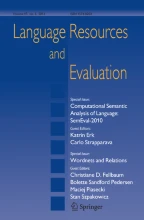Abstract
The authors here show that machine learning techniques can be used for designing an archaeological typology, at an early stage when the classes are not yet well defined. The program (LEGAL, LEarning with GAlois Lattice) is a machine learning system which uses a set of examples and counter-examples in order to discriminate between classes. Results show a good compatibility between the classes such as the yare defined by the system and the archaeological hypotheses.
Similar content being viewed by others
References
Birkhoff, G. Lattice Theory, 3rd edition. Providence, RI: Amer. Math. Society Ed., 1967.
Bonnet, C. et al. Eds. Kerma, Royaume de Nubie.Catalogue de l'exposition organisée au Musée d'art et d'histoire de Genève, 14 juin-25 novembre 1990. Edition C. Bonnet et al., Genève, 1990.
Bonnet, C. esLes fouilles archéologiques de Kerma (Soudan). Rapport préliminaire sur les campagnes de 1988-1989, 1989-1990 et de 1990-1991, dans: Genava, n.s., XXXIX, 1991, pp. 520.
Bordat, J.P. Calcul pratique du treillis de Galois d'une correspondance. Mathématiques et Sciences Humaines, 24ème année, 96 (1986), 31–47.
Brachmann, R.J. et al. "On the Epistemological Status of Semantic Networks". Associate Networks: Representation and Use of Knowledge by Computers. Ed. N.V. Findler, New-York Academic Press, 1979, pp. 3–50.
Brachmann, R.J. et al. "Knowledge Representation Support for Data Archaeology". Intl. Conf. of Information and Knowledge Management. Baltimore, MD, November 1992, pp. 457–464.
Brachmann, R.J. et al. "Integrated Support for Data Archaeology". Intl. J. of Intelligent and Cooperative Information Systems, 2(2) (1993), 159–185.
Deloche, B. Une esthétique expérimentale.LAMPAS, Université de Lyon III, 14 avenue Berthelot, 69363 Lyon Cedex 07, 1992.
Deloche, B., C. Lahanier and M. Jeanlin. "M. Jeanlin and C. Lahanier, Paris: Editions de la Maison des Sciences de l'Homme, 1993, pp. 281–
Ganascia, J.G. "TDIS: An Algebraic Formalization". Proc. of the 8th IJCAI, Chambéry, France, 2 (1993), 1008–1013.
Gardin, J.C. et al. Code pour l'analyse des formes de poteries. Paris: Editions du CNRS, 1976. Lagrange, M.S. "Symbolic Data and Numerical Processing: A Case-Study in Art History by Means of Automated Learning Techniques". Representations in Archaeology. Eds. J.-C. Gardin and C. Peebles, Bloomington: Indiana University Press, 1992, pp. 330-356.
Lehnert, M. and E. Sundheim. Artificial Intelligence Magazine, 12(3) (1991), 51–93.
Liquiere, M., E. Mephu Nguifo, M. Py and J. Sallantin. "La construction des Théories Semi Empiriques (TSE): les agents rationnels". Actes des 2ièmes Journées d'Acquisition de Connaissances}. Avril: Lannion, 1990}, pp. 51–
Mephu Nguifo, E. and J. Sallantin. "Prediction of Primate Splice Junction Gene Sequences with a Cooperative Knowledge Acquisition System". Proc of 1st Intl. conf on Intelligent Systems for Molecular Biology. Eds. L. Hunter et al., Washington D.C.: AAAI Press, July 7-9 1993, pp. 292–300.
Mephu Nguifo E. "Galois Lattice: A Framework for Concept Learning. Design, Evaluation and Refinement". Proc. of Intl. Conf. of Tools with Artificial Intelligence (TAI). New Orleans, LA: IEEE Press, November 6-9th 1994, pp. 461–467.
Mitchell, T. "Generalization as Search". Artificial Intelligence, 18(2) (1982), 203–226.
Privati, B. " Nouveaux éléments pour une classification de la céramique du Kerma Ancien". Genava, n.s., XXX (1982), 27–36.
Privati, B. "Remarques sur les ateliers de potiers de Kerma et sur la céramique du Groupe C". Genava, n.s., XXXIV (1986), 21–24.
Privati, B. "La céramique de l'établissement préKerma". Genava, n.s., XXXVI (1988), 21–24.
Privati, B. "Les ateliers de potiers et leur production". Kerma, Royaume de Nubie.Eds. C. Bonnet et al., Catalogue de l'exposition organisée au Musée d'art et d'histoire de Genève, 14 juin-25 novembre 1990, pp. 121–132. Edition C. Bonnet et al., Genève.
Quinlan, J.R. "Induction of Decisions Trees". Machine Learning, 1 (1986), 81–106. Eds. T.M. Mitchell et al
Sallantin, J., J.J. Szczeciniarz, C. Barboux, M.S. Lagrange and M. Renaud. "Théories semiempiriques: conceptualisation et illustrations". Revue d'Intelligence Artificielle, 5(1) (1991), 9-67.
Sallantin, J. Les agents intelligents. Editions Hermès, Paris, 1997.
Wille, R. "Concept Lattices & Conceptual Knowledge Systems". Computer Mathematic Applied, 23(6-9) (1992), 493–515.
Author information
Authors and Affiliations
Rights and permissions
About this article
Cite this article
Nguifo, E.M., Lagrange, MS., Renaud, M. et al. PLATA: An Application of LEGAL, a Machine Learning Based System, to a Typology of Archaeological Ceramics. Computers and the Humanities 31, 169–187 (1997). https://doi.org/10.1023/A:1000904004065
Issue Date:
DOI: https://doi.org/10.1023/A:1000904004065
